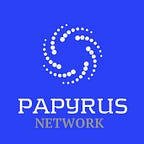Papyrus Token Economy
Papyrus is an open source scalable blockchain platform designed specifically for the digital advertising market. The solution’s value proposition is to create transparency within the supply chain, decrease unfair middleman cuts and fraud and improve brand safety. Papyrus has unique features: low transaction costs, privacy management, and the ability to execute smart contracts based on a large volume of data.
Papyrus easily integrates with existing ad platforms, verifiers and service providers. Papyrus Explorer enables digital advertisers and publishers to boost visibility on third parties and ad agencies, fight fraud, control money streams, and optimize supply chain efficiency. Unlike other existing blockchain solutions, Papyrus can process a million of data points per second, keeping transaction costs low.
Big data scalability issue is solved by Papyrus’ architecture. The Papyrus platform is composed of two programmatic layers. The channel layer facilitates the execution of smart contracts, connecting blockchain, big data, and AI algorithms through a secure off-chain data storage and processing infrastructure. The second, blockchain layer consists of an Ethereum fork that guarantees low cost and privacy protection with fast delegated Proof-of-Stake consensus and zero-knowledge proofs, as well as smart contract support.
Another core element of Papyrus is the PPR token, which is used to pay network node fees for participation in the execution of transactions and to complete payments between parties. Papyrus has its native PPR tokens and can process ERC-20 PPR tokens as well. The usage of native tokens and ERC-20 PPR tokens depends on the development stage of the Papyrus platform.
At the moment, with the successful start of the MVP stage, Papyrus processes only ERC-20 PPR tokens.
ERC-20 PPR tokens are used to:
1. Reserve ad campaign budgets on the Papyrus platform by advertisers and ad agencies
2. Make payments to publishers, ad platforms and verification vendors for displaying and verifying ads
An ad campaign will not begin until the corresponding smart contract is insured through a deposit in ERC-20 PPR.
At the stage when the Papyrus blockchain layer is launched, ERC-20 PPR tokens will become interchangeable with native Papyrus PPR tokens which offer additional functions. Native PPR tokens will be used to:
1. Register Papyrus users and make security deposits necessary to maintain security in the ecosystem
2. Enable advertisers and ad agencies to reserve ad campaign budgets on Papyrus
3. Make payments to publishers, ad platforms and verification vendors for displaying and verifying ads
4. Pay fees for the execution of Papyrus smart contracts and the usage of decentralized applications, including payments to channel nodes for input data processing. All payment transactions are commonly made in PPR tokens
5. Make staking for Papyrus blockchain layer delegated Proof-of-Stake (dPoS) consensus protocol (validators and their delegators receive rewards in PPR tokens for confirming blockchain transactions)
To summarize, Papyrus native utility tokens (PPR) are used to access the Papyrus network, pay transaction confirmation fees, make stakes in dPoS consensus to ensure network security and carry value.
There are incentives to hold and use PPR tokens. Demand for tokens will grow with the adoption of Papyrus. Integrations with new publishers, ad platforms, ad agencies and verification vendors will result in a growing Papyrus’ share of the $229B digital advertising market.
The creation of new decentralized applications on top of the platform by the development community, including AI-powered smart contracts, generate an additional upside in demand for tokens. The company’s token pool has lock-up schedules, guaranteeing dedication to the adoption of the Papyrus-powered blockchain.
